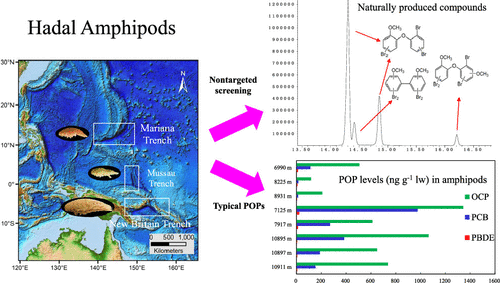当前位置:
X-MOL 学术
›
Environ. Sci. Technol.
›
论文详情
Our official English website, www.x-mol.net, welcomes your
feedback! (Note: you will need to create a separate account there.)
Occurrence of Halogenated Organic Pollutants in Hadal Trenches of the Western Pacific Ocean
Environmental Science & Technology ( IF 10.8 ) Pub Date : 2020-11-19 , DOI: 10.1021/acs.est.0c04995 Juntao Cui 1, 2 , Zhiqiang Yu 1 , Mei Mi 3 , Lisheng He 4 , Zhongli Sha 5 , Peng Yao 6 , Jiasong Fang 7, 8, 9 , Weidong Sun 5, 7
Environmental Science & Technology ( IF 10.8 ) Pub Date : 2020-11-19 , DOI: 10.1021/acs.est.0c04995 Juntao Cui 1, 2 , Zhiqiang Yu 1 , Mei Mi 3 , Lisheng He 4 , Zhongli Sha 5 , Peng Yao 6 , Jiasong Fang 7, 8, 9 , Weidong Sun 5, 7
Affiliation

|
The hadal trenches are the most remote and inaccessible habitats on earth and were once believed to be pristine. A recent study has reported the detection of high levels of persistent organic pollutants (POPs), including polybrominated diphenyl ethers (PBDEs) and polychlorinated biphenyls (PCBs), in endemic amphipods from two hadal trenches (Mariana and Kermadec) in the Western Pacific, implicating that the trenches are indeed polluted. However, a fundamental question remains unanswered, if and to what extent such the physical environment of the trenches is polluted by POPs. In this study, we sampled Mariana, Mussau, and New Britain trenches and analyzed samples of amphipods, sediment, and suspended particulate matter (SPM). Our results show that the amphipods contained elevated levels of PCBs and PBDEs, comparable to those reported in the earlier study. We also detected significantly high concentrations (up to 1343 ng g–1 lw) of chlorinated pesticides, such as dichlorodiphenyltrichloroethanes and chlordanes. Furthermore, four brominated natural products (BNPs), which structurally resembled methoxylated brominated diphenyl ethers or polybrominated biphenyls, were identified in the endemic amphipods. However, neither POPs nor BNPs were detected in sediments or SPM. Taken together, we propose that the POPs detected in endemic amphipods likely resulted from bioaccumulation by feeding on polluted large detritus (e.g., carrion) falling to the trench bottoms from the surface ocean.
中文翻译:

西太平洋Hadal沟中卤代有机污染物的发生
旱沟是地球上最偏远且人迹罕至的栖息地,曾经被认为是原始的。最近的一项研究报告说,在西太平洋两个海沟(马里亚纳河和克马德茨河)的地方性两栖动物中检测到高水平的持久性有机污染物(POPs),包括多溴二苯醚(PBDEs)和多氯联苯(PCBs),这意味着indeed沟确实被污染了。然而,一个基本问题仍然没有得到答案,即沟槽的这种物理环境是否以及在多大程度上受到持久性有机污染物的污染。在这项研究中,我们对马里亚纳(Mariana),穆索(Mussau)和新不列颠海沟进行了采样,并对两栖动物,沉积物和悬浮颗粒物(SPM)进行了分析。我们的结果表明,两栖动物的PCB和PBDEs含量较高,与早期研究中报道的结果相当。我们还检测到了很高的浓度(高达1343 ng g–1 lw)的氯化农药,例如二氯二苯基三氯乙烷和氯丹。此外,在地方性两栖动物中发现了四种结构类似于甲氧基化的溴化二苯醚或多溴联苯的溴化天然产物(BNP)。但是,在沉积物或SPM中均未检测到POPs和BNP。两者合计,我们认为在地方性两栖动物中检测到的POPs可能是由于以从被污染的大洋从地表海洋落入海沟底部的受污染的大碎屑(例如腐肉)为食而引起的生物蓄积所致。
更新日期:2020-12-15
中文翻译:

西太平洋Hadal沟中卤代有机污染物的发生
旱沟是地球上最偏远且人迹罕至的栖息地,曾经被认为是原始的。最近的一项研究报告说,在西太平洋两个海沟(马里亚纳河和克马德茨河)的地方性两栖动物中检测到高水平的持久性有机污染物(POPs),包括多溴二苯醚(PBDEs)和多氯联苯(PCBs),这意味着indeed沟确实被污染了。然而,一个基本问题仍然没有得到答案,即沟槽的这种物理环境是否以及在多大程度上受到持久性有机污染物的污染。在这项研究中,我们对马里亚纳(Mariana),穆索(Mussau)和新不列颠海沟进行了采样,并对两栖动物,沉积物和悬浮颗粒物(SPM)进行了分析。我们的结果表明,两栖动物的PCB和PBDEs含量较高,与早期研究中报道的结果相当。我们还检测到了很高的浓度(高达1343 ng g–1 lw)的氯化农药,例如二氯二苯基三氯乙烷和氯丹。此外,在地方性两栖动物中发现了四种结构类似于甲氧基化的溴化二苯醚或多溴联苯的溴化天然产物(BNP)。但是,在沉积物或SPM中均未检测到POPs和BNP。两者合计,我们认为在地方性两栖动物中检测到的POPs可能是由于以从被污染的大洋从地表海洋落入海沟底部的受污染的大碎屑(例如腐肉)为食而引起的生物蓄积所致。











































 京公网安备 11010802027423号
京公网安备 11010802027423号